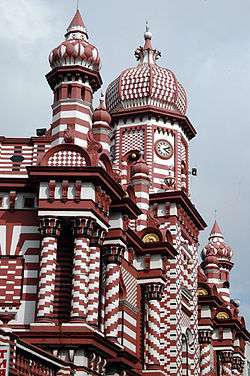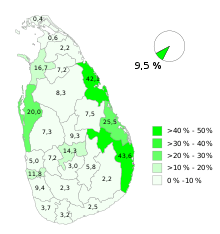Islam in Sri Lanka


Islam in Sri Lanka is practiced by 99.7%[1] of the Moorish population of Sri Lanka. 1,967,227 persons adhering Islam as per the census of 2012.[1]
History of Islam in Sri Lanka


With the arrival of Arab traders in the 7th century A.D., Islam began to flourish in Sri Lanka. The first people to profess the Islamic faith were Arab merchants and their native wives, whom they married after having them converted to Islam. By the 8th century A.D., Arab traders had controlled much of the trade on the Indian Ocean, including that of Sri Lanka. Many of them settled down on the island in large numbers, encouraging the spread of Islam. However, when the Portuguese arrived during the 16th century, many of their descendants now called the Sri Lankan Moors were mainly traders and merchants with spice trading networks spanning to the Middle East. The Portuguese colonists attacked, persecuted and destroyed the Sri Lankan Moor settlements, warehouses and trading networks. Many defeated Moors refugees escaped from the persecution to the interior in central Sri Lanka. The population of Sri Lankan Moors significantly declined during the Portuguese colonial rule due to the pograms against the Moors. The Sinhalese ruler King Senarat of Kandy gave refuge to some of the Muslims in the central highlands and Eastern Province, Sri Lanka.[2]
During 18th and 19th centuries, Javanese and Malaysian Muslims bought over by the Dutch and British rulers contributed to the growing Muslim population in Sri Lanka. Their descendants, now the Sri Lankan Malays, adapted several Sri Lankan Moor Islamic traditions while also contributing their unique cultural Islamic practices to other Muslim groups on the Island.
The arrival of Muslims from India during the 19th and 20th centuries has also contributed to the growth of Islam in Sri Lanka. Most notably, Pakistani and South Indian Muslims have introduced Shafi'i and the Hanafi school of thought into Sri Lanka, however although most Muslims on the island still adhere to the traditional practices of Sunni Islam and Fassiyatush Shadhiliyya Sufi order.
Muslims generally follow Sunni Sufi traditions like Mawlid, Tawassul and Dhikr. Ummu zavaya[3] at M.J.M.Laffir mawatha stands as the headquarters of Fassiyatush Shazuliya Sufi order which is widely practiced all over the country. Sufi Dawat-e-Islami and Deobandi Tablighi Jamaat too have centers in Colombo.[4] Sunni scholar Muhammad Abdul Aleem Siddiqi built Hanafi Masjid in Colombo for Sri Lankan Muslims.[5]
In 2012, Sri Lankan government ordered 161 foreign Tablighi Jamaat preachers to leave the country for flouting visa regulations. Local Muslims had complained that the visitors were not teaching a moderate form of Islam.[6]
In modern times, Muslims in Sri Lanka are handled by the Muslim Religious and Cultural Affairs Department, which was established in the 1980s to prevent the continual isolation of the Muslim community from the rest of Sri Lanka. Muslims of Sri Lanka, mostly from the Moor and Malay ethnic communities on the island with smaller numbers of converts from other ethnicities, such as the Tamils.
Muslims and Sri Lankan Civil War
The Sri Lankan Civil War was a 26-year conflict fought on the island of Sri Lanka between government and separatist militant organisation Liberation Tigers of Tamil Eelam (the LTTE, also known as the Tamil Tigers). In this civil war Sri Lankan Muslim were targeted by LTTE and a few hundred Muslims died {cn}, whilst hundreds of thousands were expelled from their homes and their properties were destroyed. Most of these destroyed properties belonged to Muslims and were propagated in an attempt to make northern Sri Lanka into a Tamil country called Tamil Eelam.[7]
The expulsion of the Muslims from the Northern province was an act of ethnic cleansing[8][9] carried out by the Tamil militant Liberation Tigers of Tamil Eelam (LTTE) organization in October 1990. In order to achieve their goal of creating a mono ethnic Tamil state[10][11] in the North Sri Lanka, the LTTE carried out pograms and forcibly expelled the 95,000 strong Muslim population from the Northern Province and confiscated their properties and destroyed the Mosques.[12]
The pogram and expulsion by LTTE still carries bitter memories amongst the Sri Lanka's Muslims. In 2002, the LTTE militant leader Vellupillai Prabhakaran formally apologized for the pogram and expulsion of the Muslims from the North.[13][14] There has been a stream of Muslims travelling to and from Jaffna since the ceasefire. Some families have returned and the re-opened the Osmania College now has 60 students enrolled. Osmania College was once a prominent educational institution for the city's Muslim community.[15][16] According to a Jaffna Muslim source, there is a floating population of about 2,000 Muslims in Jaffna. Around 1,500 are Jaffna Muslims, while the rest are Muslim traders from other areas. About 10 Muslim shops are functioning and the numbers are slowly growing.[17]
Sri Lankan Moors

The Sri Lankan Moors are native speakers of the Tamil language and follow Islam as their religion. Several genealogical theories point out that they belong to Tamil ethnicity and the majority of their ancestors were Tamils who had lived in the country spanning generations, and had simply converted to Islam from other faiths.[18][19][20] Other theories claim that they are all descendants of the Arabs who had settled in the island and therefore a different ethnic group. This view is held by the Sinhalese favoring section of the Moors as well as the Sri Lanka government which controversially lists them as a separate ethnic group. The Moors as per the Sri Lanka government's definition of a separate 'ethnic' community comprise about 9.2% of the country's population. This classification and their exclusion from the rest of ethnic Tamils has been critically challenged by several sources.[18][20][21]
Education
There are 749 Muslim schools in Sri Lanka, 205 madrasas which teach Islamic education, and an Islamic university in Beruwala (Jamiya Naleemiya). Al Iman Schools in Colombo was the first Islamic school of its kind, teaching an integrated Islamic curriculum since 2008. In the early 20th century there were few Muslim professionals in accountisc, medicine, engineering, etc., but at present they are exceeding the national average. Due to the lack of opportunity in Sri Lanka, many Muslim professionals are emigrating to get jobs abroad, such as to the Middle East, United States, Canada, Australia, and Europe. The Moors have had better social and economic mobility, thanks to the historic head start they had in getting education and government jobs under the British colonial rule.[20]
East Coast Moors
In the eastern provinces of the country Muslims are predominant. These Muslims were settled on land given by the Sinhalese King Senarat of Kandy after the Muslims were persecuted by the Portuguese.[2] East coast Sri Lankan Moors are primarily farmers, fishermen, and traders. According to the controversial census of 2007, the Moors are 5% (only Moors, not the entire Muslim population of the eastern province). Their family lines are traced through women, as in kinship systems of the southwest Indian state of Kerala, but they govern themselves through Islamic law.[22]
West Coast Moors
Many moors in the west of the island are traders, professionals or civil servants and are mainly concentrated in Colombo, Kalutara, Beruwala, Dharga Town, Puttalam, Jaffna and Mannar. Moors in the west coast trace their family lines through their father. Along with those in the Central Province, the surname of many Moors in Colombo, Kalutara and Puttalam is their fathers first name, thus retaining similarity to the traditional Arab and middle eastern kinship system.
The Malays

The Malays of Sri Lanka originated in Southeast Asia and today consist of about 50,000 persons. Their ancestors came to the country when both Sri Lanka and Indonesia were colonies of the Dutch. Most of the early Malay immigrants were soldiers, posted by the Dutch colonial administration to Sri Lanka, who decided to settle on the island. Other immigrants were convicts or members of noble houses from Indonesia who were exiled to Sri Lanka and who never left. The main source of a continuing Malay identity is their common Malay language (Bahasa Melayu), which includes numerous words absorbed from Sinhalese and the Moorish variant of the Tamil language. In the 1980s, the Malays made up about 5% of the Muslim population in Sri Lanka and, like the Moors, predominantly follow the Shafi school of thought within Sunni Islam.
Other Indian Muslims (Memons, Bohras, Khojas)
The Indian Muslims are those who trace their origins to immigrants searching for business opportunities during the colonial period. Some of these people came to the country as far back as Portuguese times; others arrived during the British period from various parts of India. Majority of them came from Tamil Nadu and Kerala states, and unlike the Sri Lankan Moors, are ethnically related to South Indians and number approximately 30,000. The Memon, originally from Sindh (in modern Pakistan), first arrived in 1870; in the 1980s they numbered only about 3,000, they mostly follow the Hanafi Sunni school of Islam.
The Dawoodi Bohras and the Khoja are Shi'a Muslims came from northwestern India (Gujarat state) after 1880; in the 1980s they collectively numbered fewer than 2,000. These groups tended to retain their own places of worship and the languages of their ancestral homelands.
See also
Notes
- 1 2 Department of Census and Statistics,The Census of Population and Housing of Sri Lanka-2011
- 1 2
- ↑ http://www.shazuliya.lk/
- ↑ Gugler 2011
- ↑ Roving Sufi Ambassadors of Islam
- ↑ http://www.bbc.com/news/world-asia-16675086
- ↑ "Sri Lanka – Living With Terror". Frontline. PBS. May 2002. Retrieved 9 February 2009.
- ↑ http://www.refugeesinternational.org/content/article/detail/765/
- ↑ "Sri Lanka's Muslims: out in the cold". The Hindu. Chennai, India. 2007-07-31.
- ↑ http://www.theacademic.org/feature/162395480028024/index.shtml
- ↑ "Ethnic cleansing: Colombo". The Hindu. Chennai, India. 2007-04-13.
- ↑ The “liberation” of the east heightens the anxieties of the Muslim community about its role in the new scheme of things.
- ↑ SUBRAMANIAN, T.S. (May 10, 2002). "Prabakaran in First Person". Frontline (magazine).
- ↑ "Hon. V. Prabhakaran : Press Conference at Killinochi 2002". EelamView.
- ↑ Palakidnar, Ananth (15 February 2009). "Mass resettlement of Muslims in Jaffna". Sunday Observer.
- ↑ Holmes, Walter Robert (1980), Jaffna, Sri Lanka, Christian Institute for the Study of Religion and Society of Jaffna College, p. 190
- ↑ Hindu On Net. "A timely and prudent step by the LTTE". Retrieved 2006-04-30.
- 1 2 Mohan, Vasundhara (1987). Identity Crisis of Sri Lankan Muslims. Delhi: Mittal Publications. pp. 9–14,27–30,67–74,113–118.
- ↑ Ross Brann, "The Moors?"
- 1 2 3 "Analysis: Tamil-Muslim divide". BBC News World Edition. Retrieved 6 July 2014.
- ↑ Zemzem, Akbar (1970). The Life and Times of Marhoom Wappichi Marikar (booklet). Colombo.
- ↑ "Kmaraikayar". Retrieved 2007-07-02.
References
 This article incorporates public domain material from the Library of Congress Country Studies website http://lcweb2.loc.gov/frd/cs/.
This article incorporates public domain material from the Library of Congress Country Studies website http://lcweb2.loc.gov/frd/cs/.- Victor C. de Munck. Experiencing History Small: An analysis of political, economic and social change in a Sri Lankan village. History & Mathematics: Historical Dynamics and Development of Complex Societies. Edited by Peter Turchin, Leonid Grinin, Andrey Korotayev, and Victor C. de Munck, pp. 154–169. Moscow: KomKniga, 2006. ISBN 5-484-01002-0
- Pieris, Kamalika. The Muslims and Sri Lanka..Mission Islam, 2006.